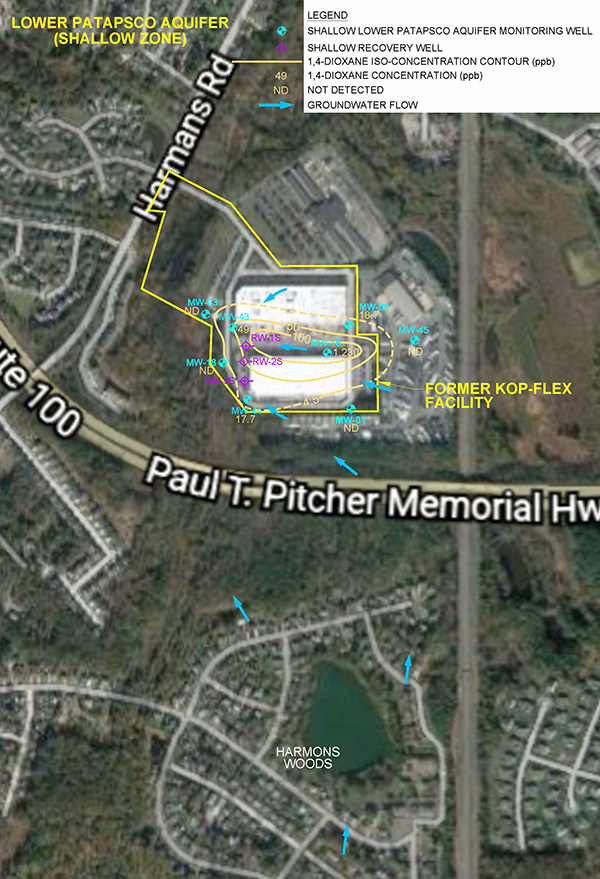Current Environmental Conditions
Onsite Groundwater and Response Action
Background
The former Kop-Flex facility and areas to the south and east are underlain by sand, silt and clay sediments of the lower portion of the Patapsco Formation. The sand-rich layers serve as the primary zones for the movement of groundwater in the subsurface. The sandy deposits present at shallow depths (less than 65 feet below ground surface at the facility property) are hereinafter referred to as the "shallow aquifer" of the Lower Patapsco aquifer system. The sand-rich layers present at greater depths in the aquifer system constitute zones of deeper, confined groundwater flow. Groundwater flow within the deep zone of is to the south and east. By contrast, the existing data indicates a generally north and west direction for groundwater flow in the shallow aquifer in the onsite and offsite area to the south.
Figure 1

View full-size version of Figure 1
Information on the groundwater quality at the former Kop-Flex facility has been gathered from the sampling of onsite monitoring wells. Evaluation of the historical monitoring data shows that concentrations of certain VOCs are present above the applicable groundwater standards in the onsite portion of the shallow aquifer. Groundwater samples collected from wells near the western property boundary show that the shallow groundwater plume does not extend offsite to the west. Figure 1 presents an iso-concentration map showing the distribution within the shallow aquifer of 1,4-dioxane, the most mobile site-related VOC. The data indicates that, before implementation of the remedy described below, VOCs present in the shallow aquifer migrated into the deeper confined zone of the Lower Patapsco aquifer system. Groundwater in this deeper confined zone tends to move to the south and east, and VOC concentrations above the groundwater standards have been detected extending away from the former Kop-Flex property, following the direction of deep groundwater flow. An iso-concentration map showing the 1,4-Dioxane distribution within the deep confined aquifer zone in both onsite and offsite areas is shown in Figure 2.
Figure 2

View full-size version of Figure 2
Both MDE and USEPA have agreed upon a hydraulic containment remedy, involving the pumping and treatment of VOC-containing groundwater at the former facility property, to address contamination in both the shallow and deep portions of the aquifer system. Since March 2017, groundwater pumping from a network of shallow extraction wells installed within the shallow aquifer zone and deep extraction wells completed in the deep aquifer zone has prevented further movement of VOC-affected groundwater beyond the former facility property. The shallow extraction wells are located in the western portion of the site near the leading edge, or front, of the shallow groundwater plume. Extraction wells to control VOC migration in the deep aquifer zone are located along the southern property boundary. The contaminated groundwater captured by the extraction wells is passed through a treatment system located on the former facility property to remove the VOCs. The treated effluent is discharged to Stony Run pursuant to a discharge permit issued by MDE. Additional information concerning the design of the hydraulic containment system is provided in the Response Action Plan (RAP) approved by MDE and USEPA in October 2015.
Although potable water at the former Kop-Flex site is obtained from the municipal water system, groundwater use at the site is prohibited pursuant to an Environmental Covenant required under the Administrative Order on Consent entered into by EMERSUB 16 and USEPA. The Environmental Covenant is recorded in the county land records.
Groundwater System Construction and Start-up
Pre-construction activities for the groundwater extraction and treatment system included the abandonment of existing monitoring wells to facilitate the property redevelopment and completion of a field demonstration test for the proposed groundwater sampling method to be used for the response action. In January 2017, a total of 15 shallow zone monitoring wells and 5 deep zone wells were abandoned in-place in accordance with the Maryland well regulations. The Response Action Plan (RAP) proposed the use of a passive sampling device (HydraSleeve® sampler) to collect groundwater samples to monitor changes in the VOC concentrations during operation of the hydraulic containment system. A field demonstration test was conducted in the spring of 2016 to evaluate the applicability and performance of the proposed sampling device to collect representative groundwater samples from the site. Based on the field test results, it was concluded that VOC concentrations in the HydraSleeve® samples are similar to the concentrations detected in historical samples collected using traditional sampling methods. (A complete discussion of the sampling data evaluation is provided in the July 2016 HydraSleeve® Field Demonstration Study Report.) Given this finding, the use of the HydraSleeve® sampling device was recommended for the long-term groundwater monitoring program at the site. MDE and EPA provided conditional approval for the use of this sampling method at the Site, with final approval pending the collection and evaluation of additional groundwater sampling data.
Construction of the groundwater remedial system was initiated in mid-September 2016 and completed in early March 2017, in accordance with the engineering design described in the approved RAP. VOC-containing groundwater is extracted from three shallow extraction wells and two deep extraction wells. The extracted groundwater is routed via underground piping to the treatment system building. The treatment system includes equipment for the following processes:
- suspended solids removal using in-line filters,
- adsorption of chlorinated VOCs and 1,4-dioxane using a specialty synthetic resin,
- pH buffering via the addition of caustic soda, and
- in-line aerators to increase dissolved oxygen levels.
The treated water is discharged to Stony Run in accordance with the requirements specified in the National Pollutant Discharge Elimination System (NPDES) permit issued by MDE, which became effective in November 2016. Detailed information on the installation of the extraction wells, and water conveyance and treatment systems is provided in the Corrective Measures Implementation (CMI) Report.
Given the pre-construction abandonment of several monitoring wells, additional wells were installed during the system construction phase to augment the remaining well network. Five shallow and two deep monitoring wells were installed at the site in accordance with the RAP. The shallow monitoring wells were located in the western portion of the Site to monitor the conditions in the shallow aquifer zone in response to pumping. The deep monitoring wells were located on the southern portion of the site to monitor the aquifer response to pumping from the deep recovery wells.
Baseline groundwater samples were collected from the monitoring and recovery wells in December 2016 and January 2017 to characterize the pre-pumping conditions in the Lower Patapsco aquifer system. Groundwater samples collected from the shallow and deep monitoring wells had similar VOC concentrations to those collected during previous sampling events. Overall, lower VOC concentrations were detected in the groundwater samples from the wells screened in the deep confined aquifer zone compared to the shallow aquifer zone, with 1,1-dichloroethene (DCE) and 1,4-dioxane being the only VOCs present at levels above the applicable groundwater cleanup standards.in both shallow and deep zones of the aquifer system. Evaluation of the sampling data indicates the distribution of 1,4-dioxane generally mimics that of 1,1-DCE within both zones of the aquifer. For the shallow aquifer zone, concentrations of 1,1-DCE and 1,4-dioxane decreased to trace and non-detect levels in samples collected from wells situated along the western (downgradient) Site boundary. No VOCs were detected at concentrations exceeding applicable cleanup criteria in samples from the shallow monitoring points near the downgradient property boundary. The baseline sampling results will be evaluated with respect to data obtained during the operation of the groundwater extraction and treatment system to assess capture of the VOC plumes and removal of contaminants from the aquifer system.
Groundwater System Operation
System start-up was initiated in early March 2017, with the groundwater pumping rate gradually increased over the first few weeks of operation while the treatment equipment and control settings were adjusted to optimize system operation. Continuous, full-scale system operation began on March 29, 2017, with groundwater extraction from all five recovery wells.
Performance of the treatment system is monitored via the collection and analysis of water samples from various points in the treatment process. Overall, the treatment system is achieving the necessary performance requirements with respect to the site contaminants. As of the end of September 2020, a total of approximately 340 pounds of chlorinated VOCs and 145 pounds of 1,4-dioxane have been removed from the impacted portions of the aquifer system. Evaluation of water level data obtained during continuous system operation indicates that groundwater extraction from the shallow and deep recovery wells is able to capture the VOC plumes on the property and prevent any future offsite transport of site-related VOCs in the aquifer system.
EMERSUB 16 plans on continuing the extraction and treatment of VOC-affected groundwater from both the shallow and deep zones of the Lower Patapsco aquifer in accordance with the requirements specified in the approved RAP. In conjunction with system operation, groundwater level and water quality monitoring activities will be regularly conducted to gather data for evaluating the effect of pumping on the aquifer system.

